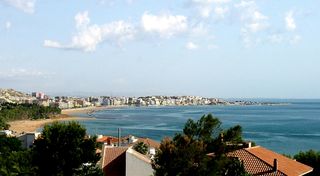
An acropolis was the settlement of an upper part of an ancient Greek city, especially a citadel, and frequently a hill with precipitous sides, mainly chosen for purposes of defense. The term is typically used to refer to the Acropolis of Athens, yet every Greek city had an acropolis of its own. Acropolises were used as religious centers and places of worship, forts, and places in which the royal and high-status resided. Acropolises became the nuclei of large cities of classical ancient times, and served as important centers of a community. Some well-known acropolises have become the centers of tourism in present-day, and, especially, the Acropolis of Athens has been a revolutionary center for the studies of ancient Greece since the Mycenaean period. Many of them have become a source of revenue for Greece, and represent some great technology during the period.

The Acropolis of Athens is an ancient citadel located on a rocky outcrop above the city of Athens, Greece, and contains the remains of several ancient buildings of great architectural and historical significance, the most famous being the Parthenon. The word Acropolis is from the Greek words ἄκρον and πόλις. The term acropolis is generic and there are many other acropoleis in Greece. During ancient times the Acropolis of Athens was also more properly known as Cecropia, after the legendary serpent-man Cecrops, the supposed first Athenian king.
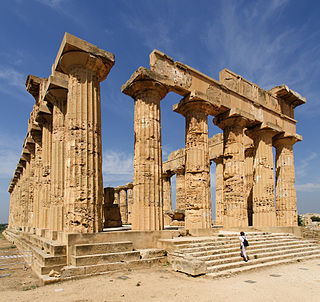
Selinunte was a rich and extensive ancient Greek city of Magna Graecia on the south-western coast of Sicily in Italy. It was situated between the valleys of the Cottone and Modione rivers. It now lies in the comune of Castelvetrano, between the frazioni of Triscina di Selinunte in the west and Marinella di Selinunte in the east.
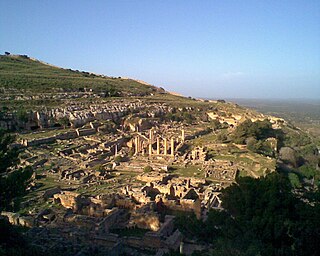
Cyrene or Kyrene was an ancient Greek and later Roman city near present-day Shahhat, Libya. It was the most important of the five Greek cities in the region, known as the pentapolis. It gave eastern Libya the classical name Cyrenaica, which it has retained to modern times.

Sybaris was an important ancient Greek city situated on the coast of the Gulf of Taranto in modern Calabria, Italy.

Lindos is an archaeological site, a fishing village and a former municipality on the island of Rhodes, in the Dodecanese, Greece. Since the 2011 local government reform it is part of the municipality Rhodes, of which it is a municipal unit. The municipal unit has an area of 178.9 km2. It lies on the east coast of the island. It is about 40 km south of the city of Rhodes and its fine beaches make it a popular tourist and holiday destination. Lindos is situated in a large bay and faces the fishing village and small resort of Charaki.

Eretria is a town in Euboea, Greece, facing the coast of Attica across the narrow South Euboean Gulf. It was an important Greek polis in the 6th and 5th century BC, mentioned by many famous writers and actively involved in significant historical events.

Paestum was a major ancient Greek city on the coast of the Tyrrhenian Sea in Magna Graecia. The ruins of Paestum are famous for their three ancient Greek temples in the Doric order dating from about 550 to 450 BC that are in an excellent state of preservation. The city walls and amphitheatre are largely intact, and the bottom of the walls of many other structures remain, as well as paved roads. The site is open to the public, and there is a modern national museum within it, which also contains the finds from the associated Greek site of Foce del Sele.

Idalion or Idalium was an ancient city in Cyprus, in modern Dali, Nicosia District. The city was founded on the copper trade in the 3rd millennium BC. Its name in the 8th century BC was "Ed-di-al" as it appears on the Sargon Stele of 707 BC, and a little later on the Prism of Esarhaddon.

Stymfalia is a village and a former municipality in Corinthia, Peloponnese, Greece. Since the 2011 local government reform, it has formed part of the municipality of Sikyona, of which it is a municipal unit. The municipal unit has an area of 205.07 km2, while its population as of 2011 was 2,427. The seat of the municipality was in Kalianoi, 41 km southwest of the town of Kiato. The municipal unit occupies a mountain valley with an average altitude of 600 metres. Mount Kyllene dominates it to the NW, rising to a height of c. 2,400 metres. The largest village is Kaisari, but the principal antiquities are just south of the modern village of Stymfalia, a hamlet of about 150 inhabitants.
Francavilla Marittima is a town and comune in the province of Cosenza in the Calabria region of southern Italy. It is known for the Timpone della Motta, a hill which was the site of an Oenotrian and ancient Greek settlement and sanctuary.
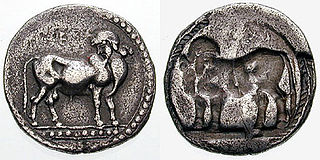
Laüs or Laus was an ancient city on the coast of the Tyrrhenian Sea. It was at the mouth of the Lao River, which formed the boundary between Lucania and Bruttium in ancient times and gave it its name.

The Temple of Aphaia or Afea is located within a sanctuary complex dedicated to the goddess Aphaia on the Greek island of Aigina, which lies in the Saronic Gulf. Formerly known as the Temple of Jupiter Panhellenius, the great Doric temple is now recognized as dedicated to the mother-goddess Aphaia. It was a favourite of the Neoclassical and Romantic artists such as J. M. W. Turner. It stands on a c. 160 m peak on the eastern side of the island approximately 13 km east by road from the main port.
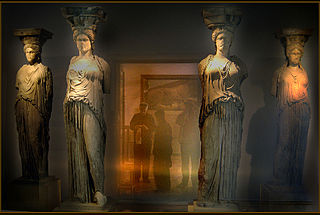
The Old Acropolis Museum was an archaeological museum located in Athens, Greece on the archeological site of Acropolis. It is built in a niche at the eastern edge of the rock and most of it lies beneath the level of the hilltop, making it largely invisible. It was considered one of the major archaeological museums in Athens. Due to its limited size, the Greek government decided in the late 1980s to build a new museum. The New Acropolis Museum is now built at the foot of the Acropolis. In June 2007 the old museum closed its doors so that its antiquities could be moved to their new home, which opened on 20 June 2009.

The Older Parthenon or Pre‐Parthenon, as it is frequently referred to, constitutes the first endeavour to build a sanctuary for Athena Parthenos on the site of the present Parthenon on the Acropolis of Athens. It was begun shortly after the battle of Marathon upon a massive limestone foundation that extended and leveled the southern part of the Acropolis summit. This building replaced a hekatompedon and would have stood beside the archaic temple dedicated to Athena Polias.

Tas-Silġ is a rounded hilltop on the south-east coast of the island of Malta, overlooking Marsaxlokk Bay, and close to the town of Żejtun. Tas-Silġ is a major multi-period sanctuary site with archaeological remains covering four thousand years, from the neolithic to the ninth century AD. The site includes a megalithic temple complex dating from the early third millennium BC, to a Phoenician and Punic sanctuary dedicated to the goddess Astarte. During the Roman era, the site became an international religious complex dedicated to the goddess Juno, helped by its location along major maritime trading routes, with the site being mentioned by first-century BC orator Cicero.

Monte Adranone is a mountain rising 900 metres above sea level in the north of the comune of Sambuca di Sicilia, in the Province of Agrigento.

Paola Zancani Montuoro was an Italian classical scholar, archaeologist, educator and writer who specialized in ancient Greek art in Italy. After participating in the restoration of monuments around Pompei, in 1934 together with Umberto Zanotti Bianco, she embarked on excavation work in Foce del Sele which revealed the Sanctuary of Hera. From 1960, she investigated the ancient sites of Sybaris and Francavilla Marittima in Magna Graecia. She was an active member of the Accademia dei Lincei from 1956, where she served as a correspondent and editor.








